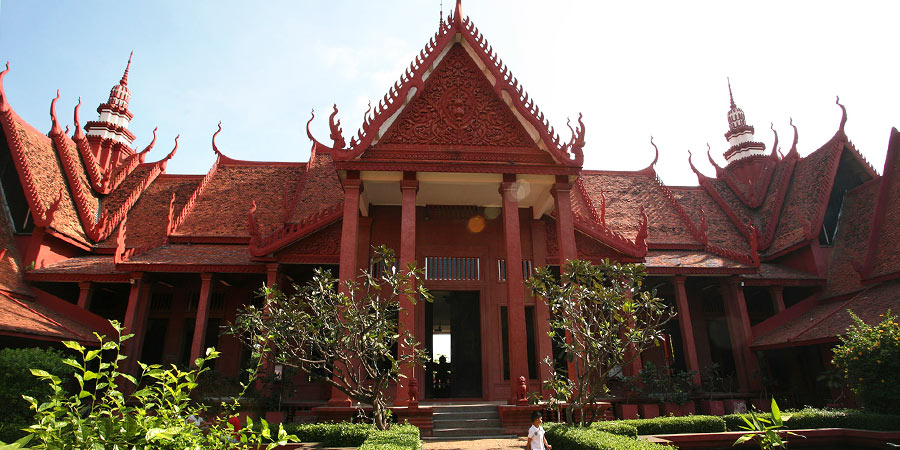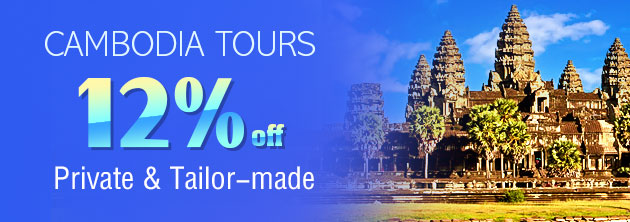National Museum of Cambodia – Explore Cambodian Artifacts and Culture
The National Museum of Cambodia is the largest and most renowned museum in the country. It boasts different artifacts that are well known for having a cultural history and archaeological significance. Only when one visits the museum, the traditional culture of Cambodia that dates back to the 4th Century becomes more transparent.Travelers flock to this famous museum throughout the year not only to witness the Cambodian artifacts that have significant cultural and historical value but also for the striking beauty of the museum. Besides the artifacts that depict Angkorian and Khmer culture and history, visitors also get captivated by the fascinating red sandstone building that houses the museum and the verdant lush green courtyard that has a couple of pair of lotus pools.
Structure of the National Museum of Cambodia & Artifacts It Boasts
The Cambodian Department of Museums is responsible for looking after the National Museum of Cambodia, which boasts one of the most significant collections of Khmer artifacts in the country and across the world. More than 14,000 valuable artifacts the museum has to its credit. The artifacts include ethnographic & ceramic objects and impressive sculpture that dates back to the Angkorian era, pre-Angkorian and post-Angkorian era too. You will find plenty of evidence of Khmer art and architecture as you will stroll through the corridors of the large structure of the National Museum of Cambodia that displays a typical Khmer artistry through its construction.

|
Make sure that your place to visit in Cambodia has a scheduled visit to the National Museum of Cambodia to make your visit complete and meaningful. The museum consists of multiple pre-historic Buddha images and sculptures made of sandstone. You will witness a statue of the Lord Yama or Leper King in the middle point of the green courtyard of the museum. The portico surrounding the courtyard grabs eyeballs owing to amazing Sanskrit, and Khmer inscriptions and stone works.
See also Terrace of the Leper King
Here are some of the facts about the National Museum of Cambodia that you need to know before you plan a visit to the place which guards the relics of the past within its periphery.
The Inception
The National Museum of Cambodia was inaugurated in 1917, and the building went under structural changes in the year 1924. However, in 1920, this museum got linked with the local artisans and art students who later on supported the museum to preserve the heritage and art of this region.However, the path has not been free from obstacles. The museum faced its hard times during the Khmer Rouge Regime when almost everything in this region went through turmoil. The art and heritage of this region also suffered during this era. Owing to lack of maintenance, the colossal building of the museum turned into a den of bats.
Once the Khmer Rouge Regime was over, the museum got its lost charm back. The walls were rebuilt, and it got opened for the public in 1979 again. It has been serving as a center of protection of art and culture for Cambodia since 1979.
Quick Facts:
• Opening time: The museum remains open for the visitors daily from 8 am to 5 pm. however; the entry gets closed at 4.30 pm.• Entry fee: Entry is free for children and school groups
$5 for foreigners aged between 10 and 17
$10 for foreigners aged 18 or above
500 riles for Cambodian
|
|
|
Religious Functions
Buddhism is the dominant religion in Cambodia. After the Angkor era, Buddhism took over, and the National Museum of Cambodia serves as a center for religious practices to uphold the spiritual heritage of the region. In 2000, a permanent exhibition got opened in the National Museum of Cambodia in association with UNESCO to extend the religious functions performed by the museum.Quick Facts:
• Tour guide: Guided tours are available, and you can opt for these tours that are available in different languages.• Smoking prohibitions: Smoking is strictly prohibited inside the museum premise
Role in Protecting Heritage within Country
The National Museum of Cambodia takes care of not only the relics and the artefacts that are there within its premises but also the ones that are spread across the other Museums within Cambodia. All the state-run museums of Cambodia get managed by the National Museum of Cambodia. Some individuals, philanthropic organizations, and foreign governments assist the Museum authorities in maintaining Khmer culture and art throughout the boundaries of the country.Quick Facts:
• Photography: Photography is strictly prohibited inside the museum. But you are free to take as many pictures as you wish, standing outside the museum. The structure of the building and the manicured gardens surrounding the museum can also be your subject for photography.• Cloakroom: Cloakrooms are available right at the entry gate. You can keep your heavy bags in the cloakrooms safely.
Protection of Khmer Art outside the Country
The National Museum of Cambodia also takes up the responsibility of reaching out to the world to create global awareness reading the Khmer art and culture. As a part of generating this awareness, the museum authorities often lend valuable artifacts to the international exhibitions where more people get to know about the history and heritage of Cambodia.Several exhibitions in the USA, Japan, South Korea, France, etc., had these Khmer artifacts and relics on display during international exhibitions.
Quick Facts:
• How to reach: A visitor who is putting up at a hotel in Phnom Penh can reach the National Museum of Cambodia quickly as it is located at the heart of the city. You can rent either a taxi or a tuktuk and pay $6-7 to reach the museum within 20 minutes. If you are travelling alone, you can also hire a motorbike for $7 per day to be in front of the museum within 10 minutes as the distance from the center of the city to the national museum of Cambodia is only 1.5 km.• Museum Store: postcards, replicas, sculptures, etc. can be had here.
To know the Khmer culture deeply, pay a visit to this museum.


